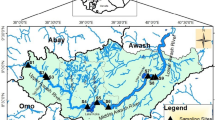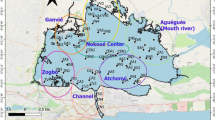Abstract
We present the concept of assemblage tolerance profiles (ATPs) as an aid to freshwater bioassessment, and illustrate it with a practical example. An ATP describes the proportion of taxa in an observed assemblage that is estimated to tolerate each level of a specific stressor within a defined range. We used an extensive compilation of biomonitoring field data to estimate the lower tolerances for pH and dissolved oxygen (DO) of common families of macroinvertebrates in rivers of south-eastern Australia. These limits were then used to establish ATPs for macroinvertebrate assemblages at 30 sites across six river systems with varying levels of exposure to drainage from disused mines and discharges from sewage treatment plants. We hypothesised that sites with more exposure to mine drainage would have ATPs indicating greater tolerance of low pH, whereas sites with more exposure to sewage discharges would have ATPs indicating greater tolerance of low DO, and found that these hypotheses were confirmed for five of the six river systems. We suggest that stressor-specific ATPs, based on tolerances derived from either field distributions or laboratory tests, can help to verify or eliminate candidate causes of inferred human impacts on aquatic ecosystems.



Similar content being viewed by others
References
Beketov, M. A., & Liess, M. (2008). An indicator for effects of organic toxicants on lotic invertebrate communities: Independence of confounding environmental factors over an extensive river continuum. Environmental Pollution, 156, 980–987. doi:10.1016/j.envpol.2008.05.005.
Bonada, N., Zamora-Muñoz, C., Rieradevall, M., & Prat, N. (2004). Ecological profiles of caddisfly larvae in Mediterranean streams: Implications for bioassessment methods. Environmental Pollution, 132, 509–521. doi:10.1016/j.envpol.2004.05.006.
Brix, K. V., De Forest, D. K., & Adams, W. J. (2011). The sensitivity of aquatic insects to divalent metals: A comparative analysis of laboratory and field data. Science of the Total Environment. doi:10.1016/j.scitotenv.2011.06.061.
Buchwalter, D. B., Cain, D. J., Clements, W. H., & Luoma, S. N. (2007). Using biodynamic models to reconcile differences between laboratory toxicity tests and field biomonitoring with aquatic insects. Environmental Science and Technology, 41, 4821–4828. doi:10.1021/es070464y.
Chapman, B. M., Jones, D. R., & Jung, R. F. (1983). Processes controlling metal ion attenuation in acid mine drainage streams. Geochimica et Cosmochimica Acta, 47, 1957–1973. doi:10.1016/0016-7037(83)90213-2.
Chessman, B. C. (1995). Rapid assessment of rivers using macroinvertebrates: A procedure based on habitat-specific sampling, family level identification and a biotic index. Australian Journal of Ecology, 20, 122–129. doi:10.1111/j.1442-9993.1995.tb00526.x.
Chessman, B. C., & McEvoy, P. K. (1998). Towards diagnostic biotic indices for river macroinvertebrates. Hydrobiologia, 364, 169–182. doi:10.1023/A:1003142819625, doi:10.1111/j.1442-9993.1995.tb00526.x.
Clements, W. H., Cherry, D. S., & Van Hassel, J. H. (1992). Assessment of the impact of heavy metals on benthic communities at the Clinch River (Virginia): Evaluation of an index of community sensitivity. Canadian Journal of Fisheries and Aquatic Sciences, 49, 1686–1694. doi:10.1139/f92-187.
Cosser, P. R. (1988). Macroinvertebrate community structure and chemistry of an organically polluted creek in south-east Queensland. Australian Journal of Marine and Freshwater Research, 39, 671–683. doi:10.1071/MF9880671.
Daniel, M. H. B., Montebelo, A. A., Bernardes, M. C., Ometto, J. P. H. B., de Camargo, P. B., Krusche, A. V., et al. (2002). Effects of urban sewage on dissolved oxygen, dissolved inorganic and organic carbon, and electrical conductivity in small streams along a gradient of urbanization in the Piracicaba River basin. Water, Air, and Soil Pollution, 136, 189–206. doi:10.1023/A:1015287708170.
Davies, P. E., Harris, J. H., Hillman, T. J., & Walker, K. F. (2010). The Sustainable Rivers Audit: Assessing river ecosystem health in the Murray–Darling Basin, Australia. Marine and Freshwater Research, 61, 764–777. doi:10.1071/MF09043.
Davis, W. S. (1995). Biological assessment and criteria: Building on the past. In W. S. Davis & T. P. Simon (Eds.), Biological assessment and criteria. Tools for water resource planning and decision making (pp. 15–29). Boca Raton: Lewis.
Davy-Bowker, J., Murphy, J. F., Rutt, G. P., Steel, J. E. C., & Furse, M. T. (2005). The development and testing of a macroinvertebrate biotic index for detecting the impact of acidity on streams. Archiv für Hydrobiologie, 163, 383–403. doi:10.1127/0003-9136/2005/0163-0383.
Gaufin, A. R., & Tarzwell, C. M. (1956). Aquatic macro-invertebrate communities as indicators of organic pollution in Lytle Creek. Sewage and Industrial Wastes, 28, 906–924.
Hawkes, H. A. (1998). Origin and development of the Biological Monitoring Working Party score system. Water Research, 32, 964–968. doi:10.1016/S0043-1354(97)00275-3.
Hilsenhoff, W. L. (1987). An improved biotic index of organic stream pollution. Great Lakes Entomologist, 20, 31–39.
Horrigan, N., Choy, S., Marshall, J., & Recknagel, F. (2005). Response of stream macroinvertebrates to changes in salinity and the development of a salinity index. Marine and Freshwater Research, 56, 825–833. doi:10.1071/MF04237.
Horrigan, N., Dunlop, J. E., Kefford, B. J., & Zavahir, F. (2007). Acute toxicity largely reflects the salinity sensitivity of stream macroinvertebrates derived using field distributions. Marine and Freshwater Research, 58, 178–186. doi:10.1071/MF05241.
Howse, R. (2007). Chironomids abound in the acid mine drainage of the Dee River, Mt Morgan. Australasian Journal of Ecotoxicology, 13, 3–8.
Kefford, B. J., Pappas, P. J., Metzeling, L., & Nugegoda, D. (2004). Do laboratory salinity tolerances of freshwater animals correspond with their field salinity? Environmental Pollution, 129, 355–362. doi:10.1016/j.envpol.2003.12.005.
Kefford, B. J., Fields, E. J., Clay, C., & Nugegoda, D. (2007). Salinity tolerance of riverine microinvertebrates from the southern Murray–Darling Basin. Marine and Freshwater Research, 58, 1019–1031. doi:10.1071/MF06046.
Kolkwitz, R., & Marsson, M. (1909). Ökologie der tierischen Saprobien. Beiträge zur Lehre von der biologischen Gewässerbeurteilung. Internationale Revue der Gesamten Hydrobiologie, 2, 126–152. doi:10.1002/iroh.19090020108.
Lottermoser, B. G. (2010). Mine Wastes. Characterization, Treatment and Environmental Impacts (3rd ed.). Berlin: Springer.
Mackey, A. P. (1988). The biota of the River Dee (Central Queensland, Australia) in relation to the effects of acid mine drainage. Proceedings of the Royal Society of Queensland, 99, 9–19.
Mantel, N. (1967). The detection of disease clustering and a generalized regression approach. Cancer Research, 27, 209–220.
McCune, B., & Mefford, M. J. (1999). PC-ORD. Multivariate Analysis of Ecological Data, Version 4. Gleneden Beach: MjM Software Design.
Norris, R. H. (1986). Mine waste pollution of the Molonglo River, New South Wales and the Australian Capital Territory: Effectiveness of remedial works at Captains Flat mining area. Australian Journal of Marine and Freshwater Research, 37, 147–157. doi:10.1071/MF9860147.
Rueda, J., Camacho, A., Mezquita, F., Hernández, R., & Roca, J. R. (2002). Effect of episodic and regular sewage discharges on the water chemistry and macroinvertebrate fauna of a Mediterranean stream. Water, Air, and Soil Pollution, 140, 425–444. doi:10.1023/A:1020190227581.
Sloane, P. I. W., & Norris, R. H. (2003). Relationship of AUSRIVAS-based macroinvertebrate predictive model outputs to a metal pollution gradient. Journal of the North American Benthological Society, 22, 457–471.
Smith, A. J., Bode, R. W., & Kleppel, G. S. (2007). A nutrient biotic index (NBI) for use with benthic macroinvertebrate communities. Ecological Indicators, 7, 371–386. doi:10.1016/j.ecolind.2006.03.001.
Taylor, G., Howse, R., Duivenvoorden, L., & Vicente-Beckett, V. (2002). Downstream flow event sampling of acid mine drainage from the historic Mt Morgan Mine. Water Science and Technology, 45(11), 29–34.
Turak, E., Flack, L. K., Norris, R. H., Simpson, J., & Waddell, N. (1999). Assessment of river condition at a large spatial scale using predictive models. Freshwater Biology, 41, 283–298. doi:10.1046/j.1365-2427.1999.00431.x.
Acknowledgements
We are grateful to the many people who produced the monitoring data from which tolerances were derived, including staff of the NSW Office of Environment and Heritage, its predecessor agencies and the following partner organisations and service providers: the Australian Water Quality Centre, the eWater Cooperative Research Centre, Ecowise Environmental, the Murray–Darling Basin Authority, the Queensland Department of Environment and Resource Management, the South Australian Environment Protection Authority, the Victorian Environment Protection Authority, Water Ecoscience, the former Water Science Laboratories and Water’s Edge Consulting. We thank the following people for providing data sets and other information: Susan Nichols (eWater Co-operative Research Centre); Greg Long and Alison Reardon (Murray–Darling Basin Authority); Sonia Claus, Jan Miller, Chris Rush and Eren Turak (NSW Office of Environment and Heritage); Monika Muschal (NSW Office of Water); Minal Khan (Queensland Department of Environment and Resource Management); Peter Goonan (South Australian Environment Protection Authority) and Lisa Singleton (Victorian Environment Protection Authority). The manuscript was improved through helpful comments from anonymous referees.
Author information
Authors and Affiliations
Corresponding author
Rights and permissions
About this article
Cite this article
Chessman, B.C., McEvoy, P.K. Insights into Human Impacts on Streams from Tolerance Profiles of Macroinvertebrate Assemblages. Water Air Soil Pollut 223, 1343–1352 (2012). https://doi.org/10.1007/s11270-011-0949-8
Received:
Accepted:
Published:
Issue Date:
DOI: https://doi.org/10.1007/s11270-011-0949-8




